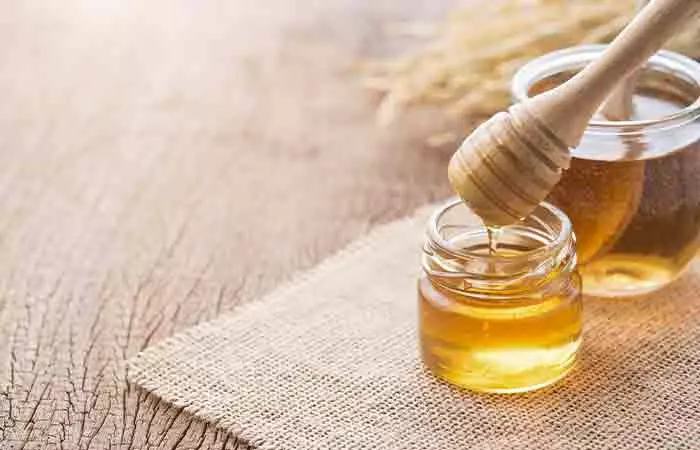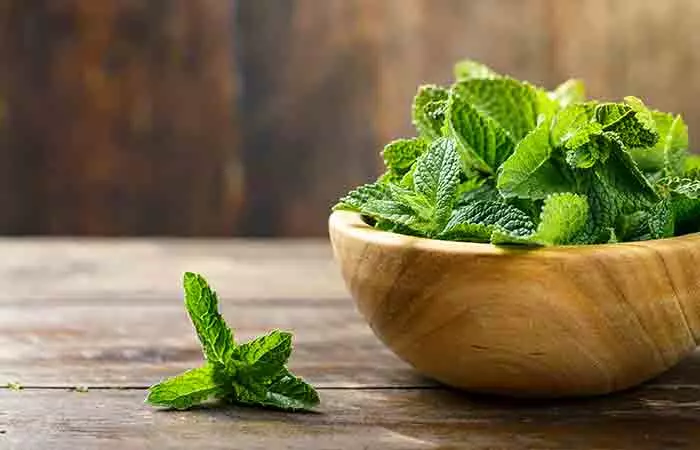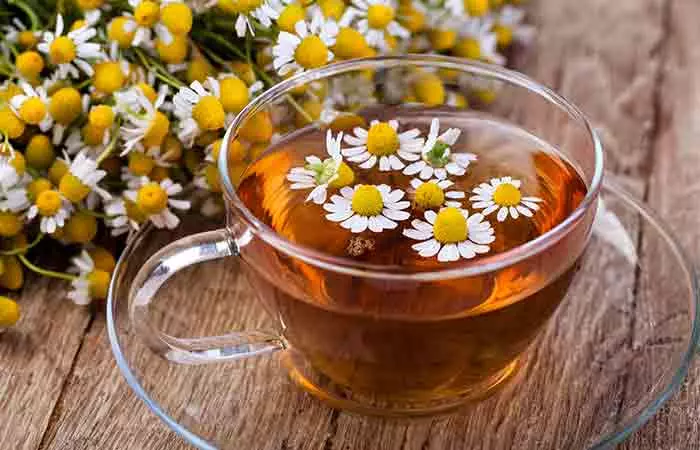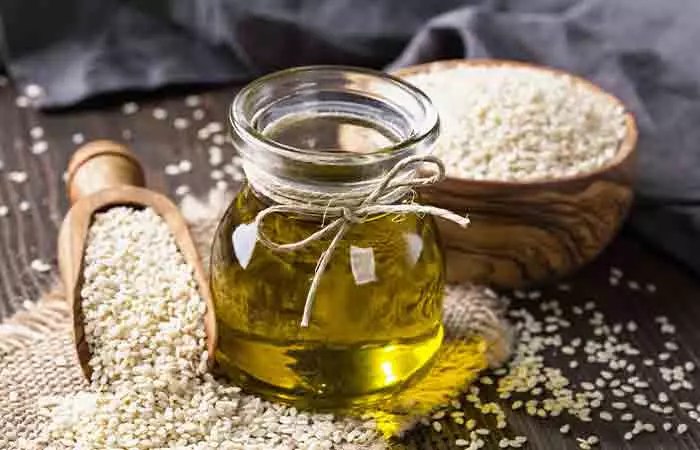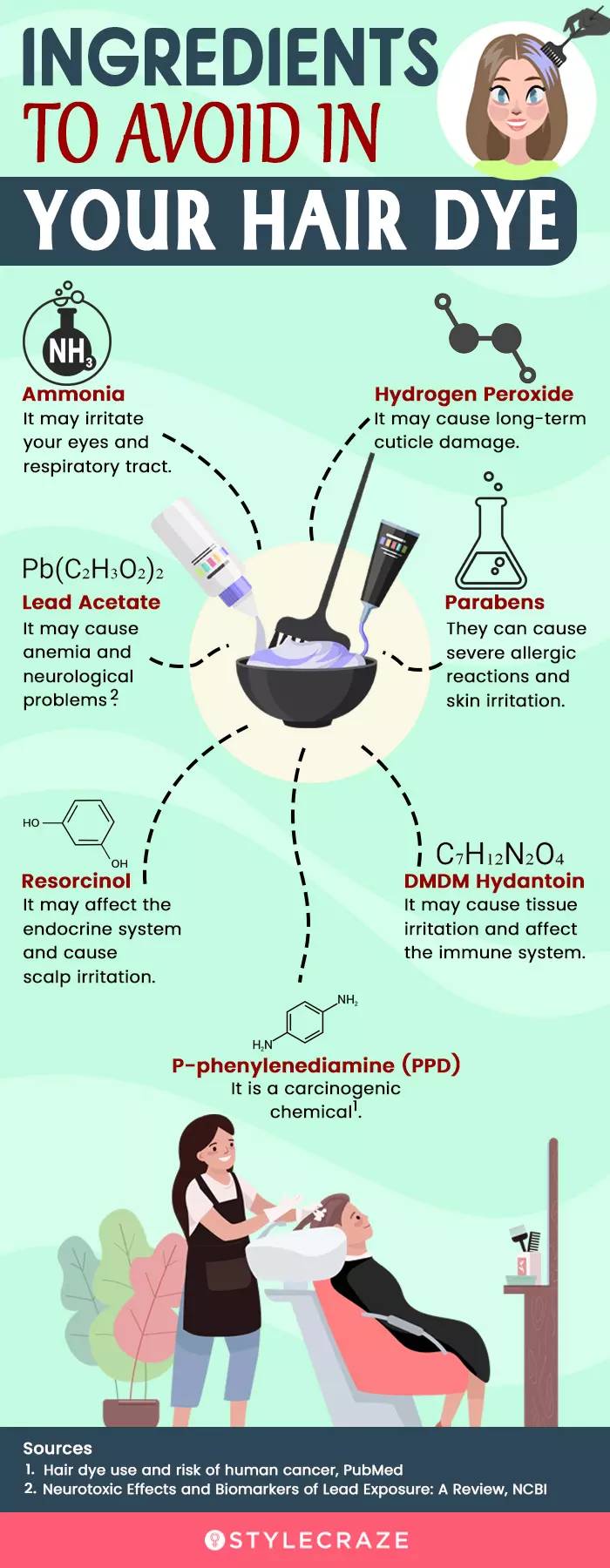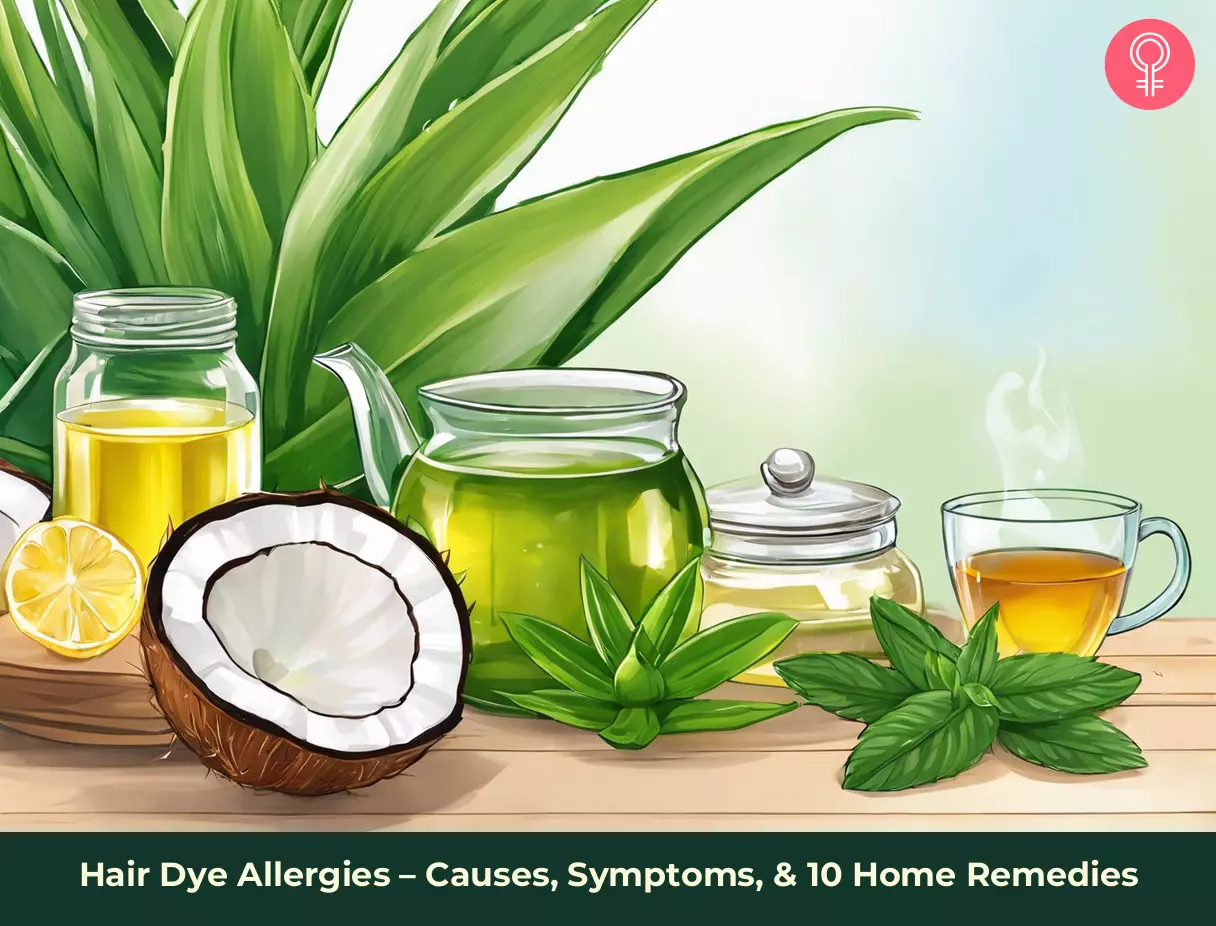Most hair dyes contain paraphenylenediamine (PPD). People with hypoallergenic skin or chemical sensitivity may experience adverse reactions to PPD (1). Don’t panic. You can easily manage hair dye allergies. Scroll down to learn about home remedies that can help you get rid of your allergy symptoms.
Do Hair Dye Ingredients Cause Allergies?
We use hair products and hair treatments to make our hair look trendy and lustrous. But these products may contain chemical ingredients that can cause an allergic reaction (like contact dermatitis). The primary ingredient in these products that causes this reaction is paraphenylenediamine (PPD). This is usually used in printer ink and temporary tattoo ink. Packaged hair dye is usually sold with an oxidizer that partially oxidizes PPD. This effect is likely to cause an allergy (1). Along with PPD, another chemical compound called para toluenediamine (PTD) is added to hair dye formulations. Though PTD could be milder than PPD, it can cause allergies (2). Dr. John Kahen, MD, a hair transplant surgeon, says, “If you have a PPD allergy, you will most likely have an allergic reaction if you bleach your hair, so it’s not usually recommended. There are some hair dyes formulated with para-toluene diamine sulfate (PTDS) instead of PPD that is tolerated by about half of the people with a PPD allergy. So, while it’s not always a safe alternative, it can be a viable option for some.”
Symptoms Of Hair Dye Allergy
The severity of your symptoms may vary. They can surface immediately or show up within 48 hours of using the hair dye. The symptoms include (2):
Red rashes on your body A stinging sensation on your scalp, face, and neck Appearance of blisters Swelling of the face and neck Inflammation of the feet, hands, eyelids, and lips
Gina Slater, a blogger, recounts her experience with a hair dye allergy that was nothing short of harrowing. She noticed her scalp was dry and itchy, her face became swollen, and she observed small lumps on the back of her neck. She writes, “I ended up in the hospital that night, I had to be injected with steroids and antihistamines, I thought I had remained calm but I had to have a drip to slow my heart rate down as it was so high from the panic of the situation (i).” Dr. Kahen adds, “Headaches are one of the most common symptoms of a hair dye allergy. If you experience a persistent headache following the use of hair dye, you should seek a doctor who may be able to prescribe an anti-allergy medication to help.” Mild symptoms may be relieved by washing the hair with a mild shampoo to remove excess dye.Gentle application of moisturizers and topical steroidsi Medicines applied to the skin to reduce inflammation and irritation caused by dermatological conditions. may help in taking care of the inflamed part of the skin. However, it is recommended to always consult a doctor before using these. Sometimes, you can develop a severe reaction to these products. Anecdotal evidence suggests that they may cause anaphylaxis, a condition characterized by fatigue, swelling of the throat, and increased difficulty in breathing. Anaphylaxis requires immediate attention, or it can turn fatal (3). Dr. Kahen adds, “If you have an allergic reaction to hair dye, it may take anywhere from a couple of days to a few weeks, depending on the severity of the symptoms. To alleviate the symptoms you can take an antihistamine to help with a possible rash, swelling, and itching. In severe cases, the allergic reaction may yield permanent effects, but this is rare. If you’re experiencing any of the above symptoms, go to a doctor to get it checked out.” Using certain home remedies can help in reducing the severity of the symptoms.
Home Remedies For Hair Dye Allergies
If you have ever had an allergic reaction to hair dye, you know it can be really uncomfortable. Luckily, some effective home remedies for allergies might help soothe the irritation and bring relief. From natural ingredients to soothing techniques, here, you will find plenty of options to ease those itchy, red reactions.
1. Honey
Honey is one of the oldest used traditional remedies for skin conditions. As it possesses immunomodulatory properties, it may help in reducing the lesions and rashes associated with atopic and contact dermatitisi It is a condition that makes skin inflamed or irritated after coming in contact with some substance or allergen. (4). You Will Need
1 tablespoon of honey Sterile gauze
What You Have To Do How Often You Should Do This Repeat 3-4 times daily until the allergy heals.
2. Aloe Vera
Aloe vera has a therapeutic effect on the skin. It possesses wound-healing and anti-inflammatory properties that may eliminate the redness and swelling associated with hair dye allergy. The plant may also promote faster healing (5). You Will Need
Aloe vera leaf or gel
What You Have To Do How Often You Should Do This You can repeat this daily.
3. Jojoba Oil
Jojoba oil has anti-inflammatory and wound-healing properties (6). It may help heal the inflamed lesions associated with hair dye allergies. The oil is also rich in wax esters that may help repair the skin and reduce scalp sensitivity (7). You Will Need
1 tablespoon of jojoba oil
What You Have To Do How Often You Should Do This You can apply this oil at least 2 times a week.
4. Coconut Oil
Coconut oil is widely used as a remedy for skin irritation. It possesses anti-inflammatory and analgesici This group of drugs helps relieve pain by selectively blocking the conduction of nerve impulses, also called painkillers. properties (8). These properties may help decrease inflammation, redness, and hives associated with hair dye allergies. Additionally, coconut oil can be a soothing choice, as it is one of the most effective home remedies for scalp pain. It offers relief from discomfort and promotes overall scalp health. You Will Need
1 tablespoon of virgin coconut oil
What You Have To Do How Often You Should Do This Do this 2 times a week.
5. Tea Tree Oil
Tea tree oil possesses anti-inflammatory properties that may help reduce the swelling and rashes caused by contact dermatitis (a possible reaction to hair dyes) (9). You Will Need
A few drops of tea tree oil 1 tablespoon of jojoba oil
What You Have To Do How Often You Should Do This Do this 2 times a week.
6. Peppermint
Peppermint possesses antipruritici They are drugs that are used to help relieve itching and can also help soothe inflammation. properties (10). Hence, it is one of the popular home remedies for an itchy scalp that soothes the redness and irritation of scaly rashes or eczema spots associated with hair dye allergy. You Will Need
1 cup of water A handful of peppermint leaves
What You Have To Do How Often Should You Do This Do this 2-3 times a week.
7. Witch Hazel
Witch hazel contains bioactive compounds, such as tanninsi A class of astringents and natural antioxidants found in plants and can reduce skin inflammation and irritation. and proanthocyanidins, that exhibit anti-inflammatory properties (11). It may help eliminate the redness, swelling, and itchiness associated with hair dye allergies. You Will Need
Witch hazel extract
What You Have To Do How Often Should You Do This Apply this to the affected areas 2-3 times a day.
8. Chamomile Tea
Chamomile has anti-inflammatory and analgesic properties (12). This may help reduce the inflammation, redness, and pain caused by an allergic reaction to the PPD in hair dyes. You Will Need
1 cup of chamomile tea
What You Have To Do How Often Should You Do This You can do this 2-3 times a week.
9. Olive Oil
Olive oil is rich in antioxidants and other phenolic compounds. These compounds exhibit anti-inflammatory properties that may be effective in alleviating the symptoms of hair dye allergies (7). You Will Need
1 tablespoon of olive oil
What You Have To Do How Often You Should Do This Repeat this 2 times a week.
10. Sesame Oil
The sesamin in sesame oil has anti-inflammatory properties (13). It may help treat hair dye allergies by soothing the red and itchy rashes and swelling. You Will Need
2 tablespoons of sesame oil
What You Have To Do How Often You Should Do This Do this 2 times a week.
11. Baking Soda
Baking soda has antibacterial properties and has been traditionally used as an effective remedy to treat skin conditions such as psoriasis. It also has antifungal properties and may reduce symptoms of fungal infections, like itchiness (14),(15). Therefore, it might be beneficial in reducing scalp irritation caused by hair dye allergies. You Will Need
1 tablespoon of baking soda 1 tablespoon of water
What You Have To Do How Often You Should Do This Do this once a week. Note: Do a patch test with the paste as baking soda may irritate sensitive skin. These home remedies may help treat hair dye allergies. But as we know, prevention is always better than cure. In the following section, we have listed certain tips you can follow.
Precautions To Bear In Mind
Always do a patch test of the product before using it. This will help minimize the chances of a possible allergic reaction. If you observe even the mildest allergic response to a chemical hair dye, stop using it immediately. If you want to get tattooed, make sure to check if you are allergic to the ink. People allergic to PPD or PTD could also be allergic to other substances, such as benzocaine, anesthetics, etc. (16). Hence, keep your doctor, dentist, and hairstylist informed to avoid any mishaps.
How long does it take to treat a hair dye allergy? If you have a mild allergic reaction to a hair dye, it will last for 7-10 days. However, if you have a more serious case of the allergy, you may experience a life-threatening condition known as anaphylaxis. In such cases, please seek immediate medical attention. Which hair dyes do not contain PPD? Most semi-permanent hair dyes may not contain PPD, but almost all dyes contain PTD. Ensure to check with your hairstylist prior to getting your hair colored. Can hair dye make you feel sick? Hair dye is formulated using chemical compounds that can cause skin toxicity. These can lead to an allergic reaction and may also make you feel sick. What can I use if I’m allergic to hair dye? You can use natural hair dyes like henna to cover your grays if you are allergic to hair dye. If you are allergic to a particular ingredient, such as paraphenylenediamine, look for dyes that do not contain this compound and have para-toluenediamine sulfates, a safer alternative, instead. Why is my head itching after hair dye? If you are allergic to the hair dye or if it contains harsh chemicals, it may irritate your scalp and lead to itching.
Illustration: Hair Dye Allergies – Causes Symptoms & 11 Home Remedies
Are you susceptible to a hair dye allergy? Watch the following informational video below to learn more about this condition and how to manage it effectively.
